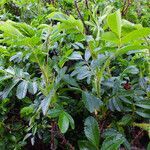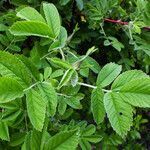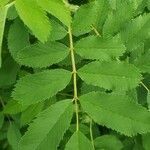Shrubs, forming thickets. Stems erect or arching, (5–)10–20 dm, sparsely branched; bark green when young, red to orange-red with age, proximally glaucous, glabrous; infrastipular prickles absent, internodal prickles rare, sparse, distal aciculi rare. Leaves 8.5–11 cm; stipules (9–)15–25 × 4–6 mm, auricles usually flared, (2.5–)4–6 mm, margins entire or serrate, sparsely to densely stipitate-glandular, surfaces glabrous, sometimes pubescent, eglandular or glandular; petiole and rachis with pricklets rare or absent, glabrous or puberulent to pubescent, sessile-or stipitate-glandular, sometimes eglandular; leaflets 5–7(–9), terminal: petiolule 5–9(–13) mm, blade elliptic or ovate, sometimes obovate, (15–)25–40(–55) × (8–)12–20(–30) mm, membranous, margins 1-serrate, teeth 10–26 per side, acute, sometimes black gland-tipped, apex acute, sometimes obtuse, abaxial surfaces pale green, glabrous, sometimes pubescent or tomentulose, eglandular, adaxial green, dull to ± lustrous, glabrous, sometimes marginally hairy. Inflorescences corymbs, 1–5(–10)-flowered. Pedicels erect, slender, 14–25 mm, glabrous, eglandular, rarely sparsely stipitate-glandular; bracts 1 or 2, ovate-lanceolate, 14–20 × 2–8 mm, margins entire, sometimes undulate, irregularly serrate, short stipitate-glandular, surfaces glabrous, glandular. Flowers 3–6(–7) cm diam.; hypanthium ovoid or globose, 4–5 × 4.5–5 mm, glabrous, eglandular, rarely stipitate-glandular, neck (0–)0.5–0.8 × 3–3.5 mm; sepals usually erect ?usually forming a beak-cap? or ± reflexed, ovate-lanceolate, (12–)20–30 × 2.5–3.5 mm, tip 2.5–4 × 0.5–1.5 mm, margins entire or pinnatifid, abaxial surfaces glabrous, stipitate-glandular, rarely eglandular; petals single, pink or rose, 13–26 × 12–26 mm; ?stamens 115?; carpels 32–55, styles exsert 1–2 mm beyond stylar orifice (1.5 mm diam.) of hypanthial disc (4 mm diam.). Hips red, subglobose to globose, sometimes ellipsoid, urceolate, or pyriform, 8–11 × 8–11 mm, fleshy, glabrous, eglandular, rarely sparsely stipitate-glandular, neck (0–)0.5–1(–1.5) × 3.5–4.5 mm; sepals persistent, erect or reflexed. Achenes basiparietal, 26, tan, 3.5–4 × 1.5–3 mm. 2n = 14.
More
Colonial; stems to 1.5 or 2 m, unarmed or with few to many slender prickles toward the base, these not extending onto the flowering branches; stipules entire to glandular-dentate; lfls mostly 5 or 7, narrowly elliptic-oblong to oval or obovate, to 5 cm, coarsely toothed, especially above the middle; fls solitary or corymbose on lateral branches from stems of the previous year; pedicels and hypanthium glabrous; sep persistent, usually erect and connivent after anthesis; pet pink, 2–3 cm; hips red, 8–15 mm thick; 2n=14. Dry woods, hills, prairies, and dunes; Que. to Man., s. to N.Y., Pa., Ind., and Mo. (R. subblanda) The stipules, rachis, and lower lf-surface are usually softly hairy or tomentulose. A striking form found along the shores of the Great Lakes, with glabrous stipules and rachis, and small, firm, glabrous lfls, may be worthy of varietal recognition. R. johannensis Fernald, occurring from Que. to Me. and n. N.Y., may represent another var., or possibly it may reflect hybridization with another sp. The lvs are glabrous or nearly so, and the persistent sep are reflexed.
A shrub. It grows 0.9-2 m high and spreads 0.9 m wide. The stems are brown and erect. It has a few prickles near the base. The leaves are dull green. The flowers are pink and occur singly. They have a mild scent. The fruit are oval hips and are red.
Can be grown by cuttings or seedlings. Seeds needs scarification.



